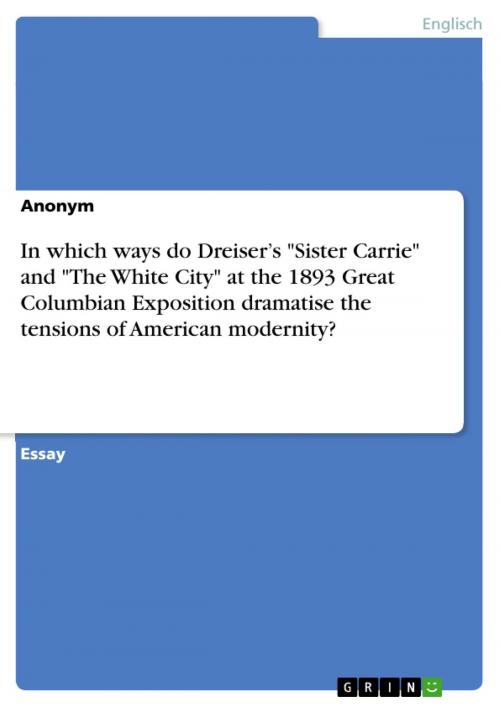In which ways do Dreiser's 'Sister Carrie' and 'The White City' at the 1893 Great Columbian Exposition dramatise the tensions of American modernity?
Nonfiction, Entertainment, Drama, Anthologies| Author: | Anonym | ISBN: | 9783656100614 |
| Publisher: | GRIN Verlag | Publication: | January 13, 2012 |
| Imprint: | GRIN Verlag | Language: | German |
| Author: | Anonym |
| ISBN: | 9783656100614 |
| Publisher: | GRIN Verlag |
| Publication: | January 13, 2012 |
| Imprint: | GRIN Verlag |
| Language: | German |
Essay aus dem Jahr 2011 im Fachbereich Amerikanistik - Literatur, , Sprache: Deutsch, Abstract: Before discussing in what way and with what results Theodore Dreiser's novel Sister Carrie(1900) and The White City at the 1893 Great Columbian Exposition dramatise the tensions of American modernity, it is necessary to define the term modernity. As Davies argues''Modernity' is a term which is notoriously difficult to define,'1 however, he suggests a 'historical understanding of modernity along the lines of the processes ... with the division of labour: fragmentation, atomization, objectification, reification and standardization.'2 Also some 'critics have highlighted the uses of modernist technology and organization for oppressive and colonial means' furthermore one 'must consider modernity as involving processes of differentiation, privileging, and marginalisation.'3 Thetensionsof American modernity can be seen as simultaneous but ambivalent developments towards liberation and constraint. While new opportunities occurred (the process of liberation), which have been unimaginable just a few years earlier, these new possibilities also involved new boundaries (constraints).
Essay aus dem Jahr 2011 im Fachbereich Amerikanistik - Literatur, , Sprache: Deutsch, Abstract: Before discussing in what way and with what results Theodore Dreiser's novel Sister Carrie(1900) and The White City at the 1893 Great Columbian Exposition dramatise the tensions of American modernity, it is necessary to define the term modernity. As Davies argues''Modernity' is a term which is notoriously difficult to define,'1 however, he suggests a 'historical understanding of modernity along the lines of the processes ... with the division of labour: fragmentation, atomization, objectification, reification and standardization.'2 Also some 'critics have highlighted the uses of modernist technology and organization for oppressive and colonial means' furthermore one 'must consider modernity as involving processes of differentiation, privileging, and marginalisation.'3 Thetensionsof American modernity can be seen as simultaneous but ambivalent developments towards liberation and constraint. While new opportunities occurred (the process of liberation), which have been unimaginable just a few years earlier, these new possibilities also involved new boundaries (constraints).















